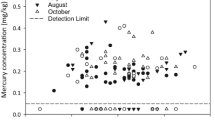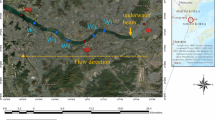Abstract
We report on long-term aqueous mercury (Hg) measurements collected at fixed locations along the Ohio River, offer insights into patterns of water and fish tissue Hg levels, and calculate site-specific bioaccumulation factors (BAFs) along an extensive longitudinal basis. We examined the relationship between total recoverable Hg concentrations in water and fish samples collected from 12 locations on the mainstem Ohio River. Water samples were collected on a bimonthly basis from each location over a 6-year period preceding the collection of fish tissue samples. This abundance of data enabled us to calculate the long-term average aqueous Hg concentrations and approximate the lifetime aqueous Hg exposure experienced by fish, enabling the calculation of appropriate BAFs. Hybrid striped bass (HSB; Morone saxatilis × M. chrysops) were collected from the Ohio River, composited (three fish), and analyzed for Hg in muscle tissue from each location. Concentrations ranged from 0.2 to 0.4 mg/kg and 41.7% of all samples collected were higher than the US Environmental Protection Agency regulatory threshold of 0.3 mg Hg/kg wet weight. Hg levels generally increased with fish weight, length, and age. However, Hg concentration in the water was the strongest predictor of tissue concentrations. We found that both water and tissue concentrations increased with drainage area, albeit at different rates. This discrepancy in spatial patterns revealed that the bioaccumulation rate of methylmercury might not be consistent throughout the Ohio River mainstem. BAFs calculated at each location supported this finding, as values decreased with increasing drainage area. Our study serves to fill critical, previously identified data gaps and provides decision-makers with the information necessary to develop more appropriate BAF development and risk-management strategies.




Similar content being viewed by others
References
ATSDR (Agency for Toxic Substances and Disease Registry) (2009) Toxicological profile for mercury. http://www.atsdr.cdc.gov/toxprofiles/tp46.html
Bloom NS (1992) On the chemical form of mercury in edible fish and marine invertebrate tissue. Can J Fish Aquat Sci 49:1010–1017
Brumbaugh WG, Krabbenhoft DP, Helsel DR, Wiener JG, Echols KR (2001) A national pilot study of mercury contamination of aquatic ecosystems along multiple gradients: bioaccumulation in fish. US geological survey water resources investigations, USGS/BRD/BSR-2001-0009. US Geological Survey, Reston, VA
Burger J, Gaines KF, Boring CS, Stephens WL Jr, Snodgrass J, Gochfeld M (2001) Mercury and selenium in fish from the Savannah River: species, trophic level, and locational differences. Environ Res 87:108–118
Cizdziel J, Hinners T, Pollard J (2003) Distribution of mercury in the tissues of five species of freshwater fish from Lake Mead, USA. J Environ Monit 5:802–807
Clarkson TW (1990) Human health risks from methylmercury in fish. Environ Toxicol Chem 9:957–961
Driscoll CT, Han Y-J, Chen CY, Evers DC, Lambert KF, Holsen TM, Kamman NC, Munson RK (2007) Mercury contamination in forest and freshwater ecosystems in the Northeastern United States. Bioscience 57:17–28
Emery EB, Simon TP, McCormick FH, Angermeier PL, Deshon JE, Yoder CO, Sanders RE, Pearson WD, Hickman GD, Reash RJ, Thomas JA (2003) Development of a multimetric index for assessing the biological condition of the Ohio River. Trans Am Fish Soc 132:791–808
Gabriel MC, Kolka R, Wickman T, Nater E, Woodruff L (2009) Evaluating the spatial variation of total mercury in young-of-year yellow perch (Perca flavescens), surface water and upland soil for watershed-lake systems within the southern Boreal Shield. Sci Total Environ 407:4117–4126
Gilmour CC, Henry EA (1991) Mercury methylation in aquatic systems affected by acid deposition. Environ Pollut 71:131–169
Gilmour CC, Riedel GS (2000) A survey of size-specific mercury concentrations in game fish from Maryland fresh and estuarine waters. Arch Environ Contam Toxicol 39:53–59
Grieb TM, Driscoll CT, Gloss SP, Schofield CL, Bowie GL, Porcella DB (1990) Factors affecting mercury accumulation in fish in the upper Michigan peninsula. Environ Toxicol Chem 9:919–930
Gutenmann WH, Ebel JG Jr, Kuntz HT, Yourstone KS, Lisk DJ (1992) Residues of p, p′-DDE and mercury in lake trout as a function of age. Arch Environ Contam Toxicol 22:452–455
Hammerschmidt CR, Fitzgerald WF (2006) Methylmercury in freshwater fish linked to atmospheric mercury deposition. Environ Sci Technol 40:7764–7770
Hurley JP, Benoit JM, Babiarz CL, Shafer MM, Andren AW, Sullivan JR, Hammond R, Webb DA (1995) Influences of watershed characteristics on mercury levels in Wisconsin rivers. Environ Sci Technol 29:1867–1875
Kehrig HA, Palermo EFA, Seixas TG, Santos HSB, Malm O, Akagi H (2009) Methyl and total mercury found in two man-made Amazonian reservoirs. J Brazil Chem Soc 20:1142–1152
Krabbenhoft DP, Wiener JG, Brumbaugh WG, Olson ML, DeWild JF, Sabin TJ (1999) A national pilot study of mercury contamination of aquatic ecosystems along multiple gradients. In: Morganwalp DW, Buxton HT (eds) U.S. geological survey toxic substances hydrology program, proceedings of the technical meeting, Charleston, SC, 8–12 March 1999. Contamination of hydrologic systems and related ecosystems, vol 2. Water resources investigations report 99-4018B. US Geological Survey, Reston, VA, pp 147–160
Kuwabra JS, Aria Y, Topping BR, Pickering IJ, George GN (2007) Mercury speciation in piscivorous fish from mining-impacted reservoirs. Environ Sci Technol 41:2745–2749
Lepak JM, Shayler HA, Kraft CE, Knuth BA (2009) Mercury contamination in sport fish in the Northeastern United States: considerations for future data collection. Bioscience 59:174–181
Mason RP (2002) The bioaccumulation of mercury, methylmercury and other toxic elements into pelagic and benthic organisms. In: Newman MC, Robert MH, Hale RC (eds) Coastal and estuarine risk assessment. CRC/Lewis Publishers, Boca Raton, FL, pp 127–149
Mason RP, Heyes D, Sveinsdottir A (2006) Mercury concentrations in fish from tidal waters of the Chesapeake Bay. Arch Environ Contam Toxicol 51:425–437
Morel FMM, Kraepiel AML, Amyot M (1998) The chemical cycle and bioaccumulation of mercury. Annu Rev Ecol Syst 29:543–566
ORSANCO (Ohio River Valley Water Sanitation Commission) (2006) Biennial assessment of Ohio River water quality conditions. Technical Report. ORSANCO, Cincinnati, OH
Piraino MN, Taylor DL (2009) Bioaccumulation and trophic transfer of mercury in striped bass (Morone saxatilis) and tautog (Tautoga onitis) from the Narragansett Bay (Rhode Island, USA). Marine Environ Res 67:117–128
Qian SS, Warren-Hicks W, Keating J, Moore DRJ, Teed RS (2001) A predictive model of mercury fish tissue concentrations for the southeastern United States. Environ Sci Technol 35:941–947
Rypel AL, Arrington DA, Findlay RH (2008) Mercury in southeastern U.S. riverine fish populations linked to water body type. Environ Sci Technol 42:5118–5124
Schell SA, Bright DJ, Marshall JA, Greenlee MA (1996) Ohio River recreation use survey 1992–1993. Ohio Department of Natural Resources, Division of Wildlife, Final Report State Project F4DR03. Ohio Department of Natural Resources, Athens, OH
Schmitt CJ, Blazer VS, Dethloff GM, Tillitt DE, Gross TS, Bryant WL Jr, DeWeese LR, Smith SB, Goede RW, Parish TM, Kubiak TJ (1999) Biomonitoring of environmental status and trends (BEST) program: field procedures for assessing the exposure of fish to environmental contaminants. US Geological Survey, Biological Resources Division, Columbia, MO
Scudder BC, Chasar LC, Wentz DA, Bauch NJ, Brigham ME, Moran PW, Krabbenhoft DP (2009) Mercury in fish, bed sediment, and water from streams across the United States, 1998–2005: US geological survey scientific investigations report 2009-5109
Sellers P, Kelly CA, Rudd JWM, Machutchon AR (1996) Photodegradation of methylmercury in lakes. Nature 380:694–697
Sorensen JA, Glass GE, Schmidt KW, Huber JK, Rapp GR Jr (1990) Airborne mercury deposition and watershed characteristics in relation to mercury concentrations in water, sediments, plankton, and fish of eighty northern Minnesota Lakes. Environ Sci Technol 24:1716–1727
Stahl LL, Snyder BD, Olsen AR, Pitt JL (2009) Contaminants in fish tissue from US lakes and reservoirs: a national probabilistic study. Environ Monit Assess 150:3–19
StatSoft, Inc (2009) STATISTICA (data analysis software system), v.9.0. Available from www.statsoft.com
USEPA (1993) Guidance for assessing chemical contaminant data for use in fish advisories: fish sampling and analysis, vol 1. EPA 823-R-93-002. USEPA, Washington, DC
USEPA (1997) Mercury study report to congress. EPA-452/R-97-003. USEPA, Washington, DC
USEPA (2001) Water quality criterion for the protection of human health: methylmercury. EPA-823-R-01-001. USEPA, Washington, DC
USEPA (2009a) National listing of fish advisories. EPA-823-F-09-007. USEPA, Washington, DC
USEPA (2009b) Methodology for deriving ambient water quality criteria for the protection of human health (2000): technical support document. Development of site-specific bioaccumulation factors, vol 3. EPA-822-R-09-008. USEPA,Washington, DC
Vallazza JM, Deller JW, Lynch WE Jr, Johnson DL (1994) Seasonal behavior, movements, and habitat preferences of hybrid striped bass and sauger in the Ohio River. Ohio Department of Natural Resources, Division of Wildlife Final Report F-69-P. Ohio Department of Natural Resources, Columbus, OH
Walters DM, Blocksom KA, Lazorchak JM, Jicha T, Angradi TR, Bolgrien D (2010) Mercury contamination in fish in mid-continent great rivers of the United States: importance of species traits and environmental factors. Environ Sci Technol 44:2947–2953
White D, Johnston K, Miller M (2005) Ohio River Basin. In: Benke AC, Cushing CE (eds) Rivers of North America. Elsevier Academic, Burlington, MA, pp 375–424
Wiener JG, Knights BC, Sandheinrich MB, Jeremiason JD, Brigham ME, Engstrom DR, Woodruff LG, Cannon WF, Balogh SJ (2006) Mercury in soils, lakes, and fish in Voyageurs National Park (Minnesota): importance of atmospheric deposition and ecosystem factors. Environ Sci Technol 40:6261–6268
Young SP, Isely IJ (2007) Diel behavior of adult striped bass using tailwater habitat as summer refuge. Trans Am Fish Soc 136:1104–1112
Acknowledgments
This article benefited greatly from the initial editorial comments and suggestions of the many federal, state, and industry reviewers and the final editorial comments and suggestions offered by two anonymous reviewers. We would like to thank the following for their various important contributions: the staff at ORSANCO that collected aqueous Hg samples, fish tissue samples, and also provided review of this manuscript; and Doug Henley (Kentucky Department of Fish and Wildlife Resources) and Dr. Charles Acosta (Northern Kentucky University) for assistance with fish aging and supplemental information.
Author information
Authors and Affiliations
Corresponding author
Rights and permissions
About this article
Cite this article
Emery, E.B., Spaeth, J.P. Mercury Concentrations in Water and Hybrid Striped Bass (Morone saxatilis × M. chrysops) Muscle Tissue Samples Collected from the Ohio River, USA. Arch Environ Contam Toxicol 60, 486–495 (2011). https://doi.org/10.1007/s00244-010-9558-6
Received:
Accepted:
Published:
Issue Date:
DOI: https://doi.org/10.1007/s00244-010-9558-6




